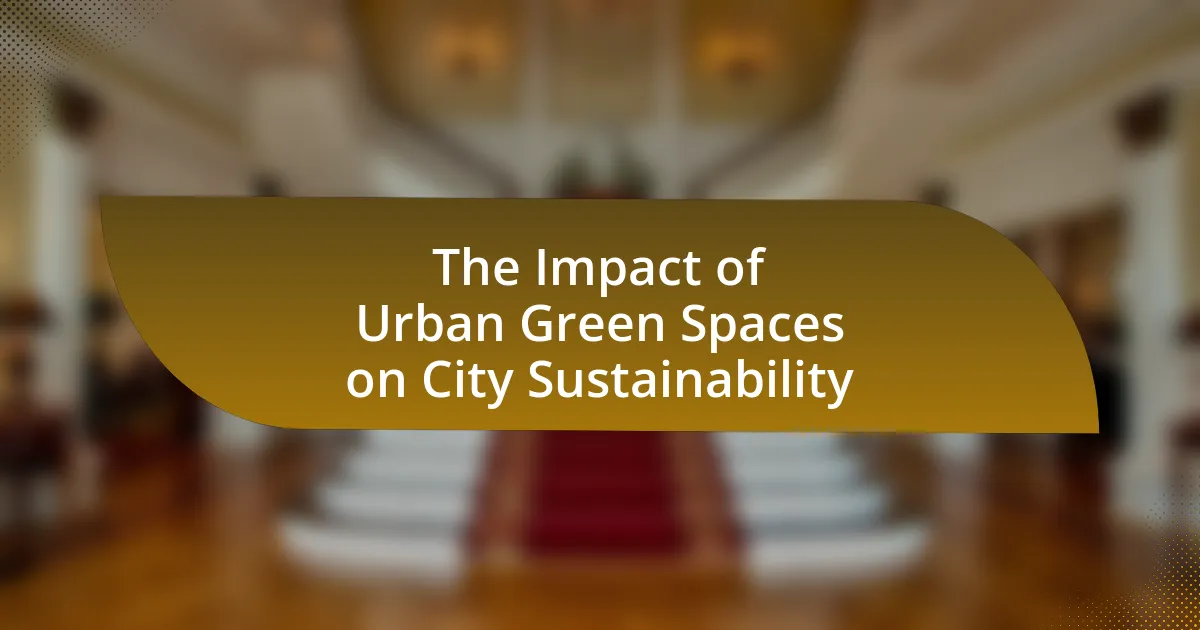The article focuses on the intersection of architecture and climate change adaptation, emphasizing the importance of designing buildings and urban spaces that can withstand climate impacts. It outlines strategies such as using sustainable materials, enhancing energy efficiency, and incorporating green infrastructure to manage stormwater and reduce urban heat. Key topics include the role of architecture in responding to climate challenges, the benefits of passive design strategies, and the financial implications of sustainable architecture. Additionally, the article discusses the challenges faced in integrating climate adaptation into architectural practices and highlights best practices for architects to enhance community resilience through adaptive design.

What is the Intersection of Architecture and Climate Change Adaptation?
The intersection of architecture and climate change adaptation involves designing buildings and urban spaces that can withstand and respond to the impacts of climate change. This includes implementing strategies such as using sustainable materials, enhancing energy efficiency, and incorporating green infrastructure to manage stormwater and reduce urban heat. For instance, the U.S. Green Building Council reports that green buildings can reduce energy use by up to 30% and water use by 50%, demonstrating the effectiveness of these adaptive strategies. By integrating climate resilience into architectural practices, the built environment can better protect communities from climate-related hazards while promoting sustainability.
How does architecture respond to climate change challenges?
Architecture responds to climate change challenges by integrating sustainable design principles, utilizing renewable materials, and implementing energy-efficient technologies. For instance, architects are increasingly adopting passive design strategies, such as natural ventilation and daylighting, which reduce reliance on mechanical heating and cooling systems. According to the U.S. Green Building Council, buildings account for approximately 39% of carbon emissions in the United States, highlighting the critical role architecture plays in mitigating climate impacts. Furthermore, the incorporation of green roofs and urban greenery not only enhances biodiversity but also helps manage stormwater, thereby addressing flooding risks associated with climate change.
What are the key climate change impacts on architectural design?
Key climate change impacts on architectural design include increased temperatures, rising sea levels, and extreme weather events. These factors necessitate the incorporation of sustainable materials, energy-efficient systems, and resilient design strategies to mitigate risks. For instance, the American Institute of Architects emphasizes that buildings must adapt to changing climate conditions by utilizing passive design techniques and renewable energy sources. Additionally, the U.S. Global Change Research Program reports that climate change can lead to more frequent and severe storms, prompting architects to design structures that can withstand such events.
How do architects incorporate sustainability into their designs?
Architects incorporate sustainability into their designs by utilizing eco-friendly materials, optimizing energy efficiency, and integrating renewable energy sources. For instance, they often select materials with low environmental impact, such as recycled steel or sustainably sourced wood, which reduces the carbon footprint of the building. Additionally, architects employ design strategies like passive solar heating and natural ventilation to minimize energy consumption, which can lead to a reduction in operational energy use by up to 50% in some cases. Furthermore, the integration of solar panels or green roofs not only generates renewable energy but also enhances biodiversity and improves urban heat management. These practices demonstrate a commitment to sustainable architecture that addresses climate change challenges effectively.
Why is climate change adaptation important in architecture?
Climate change adaptation is important in architecture because it ensures that buildings and infrastructure can withstand the impacts of climate change, such as extreme weather events, rising sea levels, and temperature fluctuations. By integrating adaptive strategies, architects can enhance the resilience of structures, thereby reducing damage and maintenance costs over time. For instance, the Intergovernmental Panel on Climate Change (IPCC) reports that climate-related disasters have increased significantly, emphasizing the need for adaptive design to protect human life and property. Furthermore, incorporating sustainable materials and energy-efficient systems in architectural design not only mitigates environmental impact but also promotes long-term sustainability, aligning with global climate goals.
What are the risks of ignoring climate change in architectural practices?
Ignoring climate change in architectural practices poses significant risks, including increased vulnerability to extreme weather events, higher operational costs, and diminished building longevity. Architects who neglect climate considerations may design structures that are ill-equipped to withstand rising temperatures, flooding, and severe storms, leading to potential structural failures and safety hazards. Additionally, buildings that do not incorporate energy-efficient designs contribute to higher energy consumption, resulting in increased utility costs and a larger carbon footprint. According to the Intergovernmental Panel on Climate Change, buildings account for approximately 39% of global carbon emissions, underscoring the importance of sustainable architectural practices. Furthermore, failure to adapt to climate change can lead to regulatory penalties and decreased property values, as communities increasingly prioritize resilience and sustainability in their development plans.
How can adaptive architecture enhance community resilience?
Adaptive architecture enhances community resilience by creating flexible and responsive built environments that can adjust to changing climate conditions and community needs. This architectural approach incorporates features such as modular designs, sustainable materials, and smart technologies that allow structures to withstand extreme weather events, reduce energy consumption, and promote social cohesion. For instance, buildings designed with adaptive facades can optimize natural light and ventilation, thereby reducing reliance on artificial heating and cooling systems. Research indicates that communities employing adaptive architecture experience lower recovery times after disasters, as these structures are better equipped to handle disruptions. A study by the National Institute of Building Sciences found that resilient buildings can save communities up to $4 for every $1 invested in resilience measures, demonstrating the economic benefits of adaptive architecture in enhancing community resilience.

What strategies are used in architecture for climate change adaptation?
Strategies used in architecture for climate change adaptation include designing buildings to withstand extreme weather, utilizing sustainable materials, and implementing green infrastructure. These strategies aim to enhance resilience against climate impacts such as flooding, heatwaves, and storms. For instance, elevated structures in flood-prone areas reduce water damage risk, while green roofs and walls improve insulation and manage stormwater. Research indicates that incorporating passive solar design can reduce energy consumption by up to 30%, demonstrating the effectiveness of these adaptive strategies in mitigating climate change effects.
How do architects implement passive design strategies?
Architects implement passive design strategies by optimizing building orientation, utilizing natural ventilation, and incorporating thermal mass. These strategies enhance energy efficiency and reduce reliance on mechanical systems. For instance, orienting a building to maximize sunlight exposure can significantly decrease heating costs in colder climates, while strategically placed windows can facilitate cross-ventilation, improving indoor air quality and comfort. Research indicates that buildings designed with passive strategies can achieve energy savings of up to 50% compared to conventional designs, demonstrating their effectiveness in climate change adaptation.
What are the benefits of passive solar design in buildings?
Passive solar design in buildings offers significant benefits, including energy efficiency, reduced utility costs, and enhanced occupant comfort. By strategically positioning windows, walls, and roofs, passive solar design maximizes natural light and heat from the sun, which can lead to a reduction in reliance on artificial heating and cooling systems. According to the U.S. Department of Energy, buildings designed with passive solar principles can achieve energy savings of 30% to 50% compared to conventional designs. Additionally, passive solar design contributes to lower greenhouse gas emissions, aligning with climate change adaptation strategies by promoting sustainable building practices.
How does natural ventilation contribute to energy efficiency?
Natural ventilation enhances energy efficiency by reducing the reliance on mechanical cooling and heating systems. By allowing fresh air to flow through buildings, natural ventilation helps maintain comfortable indoor temperatures, thereby decreasing energy consumption. Studies indicate that buildings designed with effective natural ventilation can achieve energy savings of up to 30% compared to those relying solely on mechanical systems. This reduction in energy use not only lowers utility costs but also minimizes greenhouse gas emissions, aligning with climate change adaptation strategies in architecture.
What role does technology play in climate-responsive architecture?
Technology plays a crucial role in climate-responsive architecture by enabling the design and implementation of sustainable building practices that reduce environmental impact. Advanced technologies such as Building Information Modeling (BIM), energy-efficient systems, and smart materials facilitate the optimization of energy use, enhance resource management, and improve indoor environmental quality. For instance, the integration of solar panels and green roofs not only harnesses renewable energy but also mitigates urban heat effects, demonstrating how technology can directly contribute to climate resilience in architectural design.
How can smart building technologies improve energy management?
Smart building technologies can improve energy management by utilizing advanced sensors, automation, and data analytics to optimize energy consumption. These technologies enable real-time monitoring of energy usage, allowing for adjustments based on occupancy and environmental conditions. For instance, smart thermostats can learn user preferences and adjust heating and cooling systems accordingly, leading to energy savings of up to 15% according to the U.S. Department of Energy. Additionally, integrating renewable energy sources, such as solar panels, with smart grid technology allows buildings to manage energy supply and demand more efficiently, further enhancing energy management capabilities.
What innovations are emerging in sustainable building materials?
Innovations in sustainable building materials include the development of bio-based materials, such as mycelium and hempcrete, which offer lower carbon footprints compared to traditional materials. Mycelium, derived from fungi, can be grown into specific shapes and is biodegradable, while hempcrete, made from hemp fibers, provides excellent insulation and is carbon-negative. Additionally, advancements in recycled materials, like reclaimed wood and recycled plastics, are gaining traction, as they reduce waste and resource consumption. According to a report by the World Green Building Council, the use of sustainable materials can significantly lower greenhouse gas emissions in the construction sector, highlighting the importance of these innovations in addressing climate change.

What are the challenges faced in integrating climate change adaptation in architecture?
Integrating climate change adaptation in architecture faces several challenges, including financial constraints, regulatory hurdles, and a lack of interdisciplinary collaboration. Financially, the initial costs of sustainable materials and technologies can deter architects and developers, despite long-term savings and benefits. Regulatory hurdles arise from outdated building codes that may not accommodate innovative designs aimed at climate resilience. Additionally, effective adaptation requires collaboration across various fields, including environmental science and urban planning, which is often lacking, leading to fragmented approaches. These challenges hinder the ability to create resilient architectural solutions that effectively address the impacts of climate change.
What are the financial implications of sustainable architecture?
Sustainable architecture has significant financial implications, primarily through cost savings, increased property value, and potential tax incentives. Implementing energy-efficient systems and sustainable materials can reduce operational costs by up to 30% over the building’s lifecycle, as reported by the U.S. Green Building Council. Additionally, properties designed with sustainable practices often see a higher market value; studies indicate that green buildings can command a price premium of 7% to 10% compared to conventional buildings. Furthermore, various governments offer tax credits and incentives for sustainable building practices, which can offset initial construction costs. These financial benefits demonstrate that sustainable architecture not only contributes to environmental goals but also provides a compelling economic rationale for developers and investors.
How do initial costs compare to long-term savings in green buildings?
Initial costs for green buildings are typically higher than conventional buildings, but they lead to significant long-term savings. Studies indicate that green buildings can reduce energy costs by 30-50% and water costs by 30% compared to traditional structures. For instance, the U.S. Green Building Council reports that over a 20-year period, the operational savings from energy efficiency and reduced utility costs can exceed the initial investment by a factor of 2 to 3 times. This financial advantage is further supported by the fact that green buildings often have higher occupancy rates and increased property values, making them a financially sound choice in the long run.
What funding opportunities exist for climate-adaptive projects?
Funding opportunities for climate-adaptive projects include government grants, private sector investments, and international financial mechanisms. For instance, the Green Climate Fund provides financial support to developing countries for climate-resilient projects, while the Global Environment Facility offers grants for environmental projects, including those focused on climate adaptation. Additionally, organizations like the World Bank and the United Nations Development Programme offer funding specifically aimed at enhancing resilience to climate change. These funding sources are crucial for implementing innovative architectural solutions that address climate challenges effectively.
How do regulatory frameworks impact climate change adaptation in architecture?
Regulatory frameworks significantly influence climate change adaptation in architecture by establishing guidelines and standards that promote sustainable building practices. These frameworks often mandate energy efficiency, resilience to extreme weather, and the use of sustainable materials, which directly affect design and construction processes. For instance, building codes may require structures to withstand increased flooding or heat, thereby encouraging architects to incorporate adaptive features such as elevated foundations or green roofs. Additionally, regulations can incentivize the adoption of renewable energy technologies, further enhancing a building’s capacity to adapt to climate change. Evidence of this impact can be seen in cities like New York, where the implementation of the NYC Climate Resiliency Design Guidelines has led to the integration of adaptive measures in new developments, demonstrating a clear link between regulatory frameworks and climate-responsive architecture.
What building codes support sustainable design practices?
Building codes that support sustainable design practices include the International Green Construction Code (IgCC), ASHRAE 189.1, and the LEED rating system. The IgCC establishes minimum requirements for green building design, construction, and operation, promoting energy efficiency and resource conservation. ASHRAE 189.1 provides a framework for high-performance green buildings, focusing on energy use, water efficiency, and indoor environmental quality. The LEED rating system, developed by the U.S. Green Building Council, offers a certification process that encourages sustainable building practices through a points-based system across various categories, including energy, water, and materials. These codes and standards collectively aim to reduce the environmental impact of buildings and enhance their resilience to climate change.
How can architects navigate zoning laws for adaptive reuse projects?
Architects can navigate zoning laws for adaptive reuse projects by thoroughly researching local regulations and engaging with planning authorities early in the design process. Understanding the specific zoning classifications, permitted uses, and any overlay districts that may apply to the property is crucial. For instance, many municipalities have specific guidelines for historic preservation that can impact adaptive reuse, requiring architects to align their designs with these regulations. Additionally, architects can advocate for zoning variances or amendments when necessary, demonstrating how the proposed reuse aligns with community goals, such as sustainability and economic development. Engaging with community stakeholders can also facilitate smoother navigation of zoning laws, as it builds support for the project and addresses potential concerns upfront.
What best practices can architects adopt for effective climate change adaptation?
Architects can adopt several best practices for effective climate change adaptation, including designing for resilience, utilizing sustainable materials, and implementing energy-efficient systems. Designing for resilience involves creating structures that can withstand extreme weather events, such as floods and hurricanes, which are becoming more frequent due to climate change. For instance, elevating buildings in flood-prone areas can significantly reduce damage during heavy rainfall.
Utilizing sustainable materials, such as recycled or locally sourced products, minimizes the carbon footprint of construction and promotes environmental stewardship. Additionally, implementing energy-efficient systems, like solar panels and green roofs, not only reduces energy consumption but also enhances the building’s ability to adapt to changing climate conditions.
Research from the Intergovernmental Panel on Climate Change (IPCC) highlights that buildings account for approximately 40% of global energy consumption, emphasizing the importance of energy efficiency in architectural design. By integrating these practices, architects can contribute to a more sustainable and resilient built environment in the face of climate change.
How can community engagement enhance adaptive architectural solutions?
Community engagement enhances adaptive architectural solutions by incorporating local knowledge and preferences into design processes. This involvement ensures that structures are not only functional but also culturally relevant and environmentally sustainable. For instance, research by the American Institute of Architects indicates that projects with community input are 30% more likely to meet the needs of residents and adapt effectively to climate challenges. Engaging communities allows architects to identify specific vulnerabilities and opportunities unique to the area, leading to more resilient designs that can better withstand climate impacts.
What resources are available for architects to stay informed on climate adaptation strategies?
Architects can utilize various resources to stay informed on climate adaptation strategies, including professional organizations, academic journals, and online platforms. The American Institute of Architects (AIA) provides guidelines and resources focused on sustainable design and climate resilience. Additionally, the journal “Building and Environment” publishes peer-reviewed research on environmental impacts and adaptation strategies relevant to architecture. Online platforms like the Climate Adaptation Knowledge Exchange (CAKE) offer case studies and tools specifically for professionals in the field. These resources collectively support architects in integrating climate adaptation into their design practices.






































-of-Building-Materials-1.webp)

